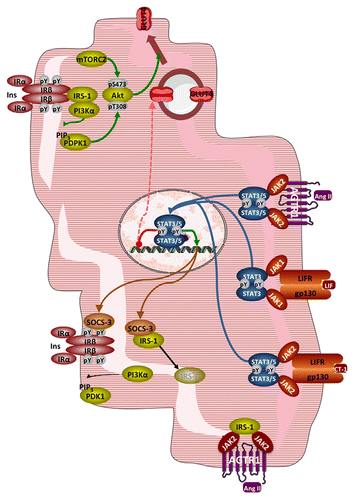Figures & data
Figure 1. Principal points of regulation of glucose metabolism in cardiac myocytes. Glucose enters cardiac myocytes by facilitated diffusion through GLUT (mostly GLUT4) transporters and to a minor extent by cotransport with sodium through SGLT1. Glycolysis yields pyruvate, which is converted to acetyl-CoA to undergo mitochondrial oxidation in the Krebs cycle. Principal points of regulation are transmembrane transport, regulated by translocation of GLUT4, the PFK-1 reaction, which is stimulated by F2,6BP, and activity of the pyruvate dehydrogenase complex, regulated by phosphorylation by PDH kinases or dephosphorylation by PDH phosphatases. See text for details. Abbreviations: AMPK, AMP-activated protein kinase; F1,6BP, fructose-1,6-bisphosphate; F2,6BP, fructose-2,6-bisphosphate; F6P, fructose-6-phosphate; GLUT1 or 4, facilitative glucose transporters; Ins, insulin; IRα/β, insulin receptor, subunit α, respectively β; PDC, pyruvate dehydrogenase complex; PDK1-4, pyruvate dehydrogenase kinase 1 to 4; PDPC1-2, pyruvate dehydrogenase phosphatase 1 or 2; PFK-1, 6-phosphofructo-1-kinase; PFK-2, 6-phosphofructo-2-kinase; SGLT1, sodium-glucose cotransporter 1; WISK, wortmannin-sensitive and insulin-stimulated protein kinase.

Figure 2. Interference of JAK-STAT signaling with insulin signaling and glucose transport in cardiac myocytes. Top: Normal insulin signaling leading to Akt activation and translocation of GLUT4. Right: activation of JAK-STAT signaling by Ang II, LIF, and CT-1 leading to SOCS3 overexpression and GLUT4 repression. Left: disruption of insulin signaling by SOCS3, with dissociation and degradation of IRS-1. Bottom: sequestration of IRS-1 by JAK2 activated by the ligand-bound AGTR1. See text for details. Abbreviations: Ang II, angiotensin II; AGTR1, angiotensin receptor type 1; CT-1, cardiotrophin-1; gp130, glycoprotein 130; IRS-1, insulin receptor substrate 1; LIF, leukemia inhibitory factor; LIFR, LIF receptor; mTORC2, mammalian target of rapamycin complex 2; PDPK1, phosphoinositide-dependent protein kinase 1; PI3Kα, phosphoinositide 3-kinase α; PIP3, phosphatidylinositol-3,4,5-trisphosphate; pY, phosphotyrosine; SOCS3, suppressor of cytokine signaling 3.
